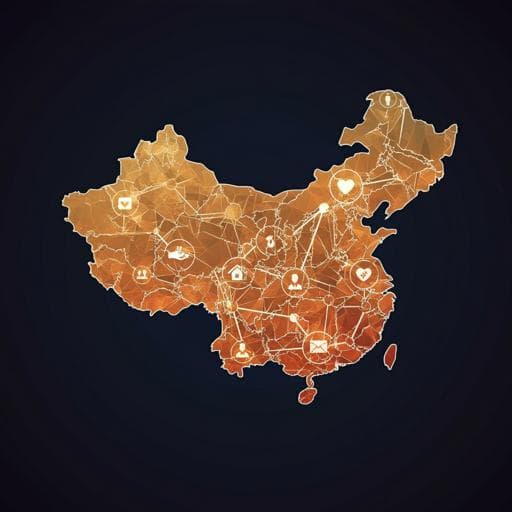
Economics
The contribution of data-driven poverty alleviation funds in achieving mid-21st-Century multidimensional poverty alleviation planning
D. Yang, W. Luan, et al.
Explore how data-driven poverty alleviation funds (PAFs) can revolutionize efforts to eradicate multidimensional poverty, as examined by Di Yang, Weixin Luan, Jun Yang, Bing Xue, Xiaoling Zhang, Hui Wang, and Feng Pian. This study highlights an innovative model applicable to developing countries, emphasizing the role of multidimensional development indicators.
~3 min • Beginner • English
Introduction
The UN’s first SDG seeks to end poverty in all its forms by 2030, calling for coordinated progress across economic, environmental, resource, welfare, and other sectors. Poverty is now understood as multidimensional rather than solely economic. While the MDGs lifted over a billion people from extreme poverty, gaps remain in deploying multifaceted social indicators. China’s targeted poverty alleviation, largely through poverty alleviation funds (PAFs), has lifted more than 700 million people out of poverty. Yet, to inform policy, understanding the dynamics between multidimensional poverty indices (MPIs) and PAFs and performing scenario analyses is necessary. The study addresses three questions: (1) What was the status of multidimensional poverty globally prior to SDG implementation? (2) What future SSP tendencies characterize regions such as China, the United States, India, and the Middle East/Africa? (3) What is the future tendency of a PAFs-SSPs-influenced MPI in China?
Literature Review
The MPI developed by the Oxford Poverty and Human Development Project/UNDP measures poverty via weighted deprivations in health, education, and living standards; extended frameworks incorporate human, natural, financial, physical, and social capital. Challenges remain in creating global MPI frameworks that capture development dynamics and spatial heterogeneity. Nighttime light satellite imagery (NLS) is an effective proxy for monitoring regional poverty where data are scarce. Prior work used DMSP/OLS and NPP/VIIRS with machine learning to identify high-poverty counties in China. Multisource data fusion (NLS, MODIS, statistical data) enables unified MPI frameworks. The IPCC’s SSPs (SSP1–SSP5) are widely used to project climate, urban land, and socioeconomic outcomes; methods have been proposed to assess global poverty under scenarios and to quantify long-term sustainability. However, research linking MPI to SSPs and to PAF-guided policy simulations remains limited.
Methodology
Data: MPI compiled for 2369 Chinese counties (1998–2020) from statistical yearbooks, NLS (DMSP/OLS; NPP/VIIRS, 2000–2017), and MODIS. MPI dimensions include environment (altitude, slope, vegetation coverage/NDVI, biological land quality), resources (per capita land resource ownership; per capita output of agriculture/forestry/animal husbandry/fishery), social welfare (hospital beds; middle school students), and economy (total GDP, GDP per capita, retail sales per capita, rural disposable income per capita, average night light intensity). Benchmark labels derive from the 592 key national poverty alleviation counties (574 with complete data).
Weighting framework: Index normalization and entropy weight were combined with Monte Carlo simulation to emulate human-like scoring and perform online learning of MPI weights that maximize accuracy in identifying 2012 poverty counties. Repeated simulations adjust weights under boundary constraints informed by frequency spectra and prior knowledge.
Machine learning for imputation/prediction: Nonlinear relationships between NLS digital numbers (DN) and MPI were learned using polynomial fitting, SVM, decision trees, neural networks, ensemble trees, and random forest. These relationships were used to impute missing indices and predict MPI where county statistics were incomplete. Model selection used RMSE; random forest performed best. County development classes (extreme-poverty, generally poverty, poverty, primary developed, medium developed, advanced developed) were assigned via Jenks natural breaks (G* fracture).
Modeling MPI–PAF relationship: Piecewise functions learned by least squares modeled MPI response to PAFs for poor counties, non-poor counties, and average growth rates. Region-specific models permit heterogeneity in PAF effectiveness.
PAFs-SSPs scenarios and allocation: A data-driven Monte Carlo simulation framework allocated provincial PAFs under SSP1–SSP5, reflecting different policy logics: SSP1 (sustainability/green road) coordinates inter-provincial differences and balances economy–resources–environment–welfare; SSP2 (middle of the road) funds only provinces containing poor counties; SSP3 (rocky road) prioritizes provinces with many poor counties, others rely on self-development; SSP4 (road divided) concentrates on counties near the poverty boundary and provinces with many poor counties; SSP5 (fossil-fueled development) prioritizes rapid economic gains with random weights increasing resource consumption at the expense of environment. Allocation weights use exponential functions of MPI, counts of poor counties (Gaussian-distributed thresholds), and boundaries such as the poverty line (BMPI).
Simulation design: Three-layer Monte Carlo simulation varied total PAFs, random noise (to reflect data uncertainty), and aspect weights (particularly in SSP5). Annual time steps updated MPI growth rates conditional on PAFs. For future Chinese county scenarios, 1,000,000 simulations explored uncertainty in timing, regional targeting, and magnitude of PAF investments up to 2050. Global/country-level SSP projections used OECD/SSP GDP and population with environmental forcing to simulate 2015–2050 MPI trajectories for China, the US, India, and the Middle East/Africa.
Key Findings
- Random forest yielded the best MPI prediction from NLS among tested algorithms (reported RMSE as low as 0.41), outperforming polynomial, SVM, decision tree, and other methods.
- Monte Carlo-derived MPI weights (identification accuracy >80%): economy 0.467±0.033 > social welfare 0.385±0.014 > resources 0.131±0.020 > environment 0.017±0.003, highlighting the dominant role of economic and social welfare dimensions in identifying poverty counties.
- Global/country SSP MPI change rates (approximate annual change; mean (std)):
• China: SSP1 0.16 (0.013), SSP2 0.097 (0.008), SSP3 0.053 (0.025), SSP4 0.12 (0.01), SSP5 0.202 (0.022).
• United States: SSP1 0.107 (0.009), SSP2 0.063 (0.017), SSP3 0.0579 (0.015), SSP4 0.115 (0.003), SSP5 0.123 (0.006).
• India: SSP1 0.08 (0.042), SSP2 0.025 (0.017), SSP3 0.0048 (0.0015), SSP4 0.044 (0.023), SSP5 0.0814 (0.054).
• Middle East/Africa: SSP1 0.05 (0.024), SSP2 0.016 (0.008), SSP3 0.0014 (0.0011), SSP4 0.015 (0.005), SSP5 0.057 (0.039).
- China’s MPI growth rate exceeds that of India, Middle East/Africa, and the US, suggesting convergence between China and the US in future MPI. Despite China’s eradication of extreme poverty in 2020, India and Middle East/Africa are projected to need an additional 10–14 years to reach comparable levels, complicating SDG1 timelines.
- Spatial evolution under SSP1 in China:
• 2012: extreme poverty 29%, generally poverty 33.7%, primary developed 10.3%, moderately developed 8.6%, advanced developed 0%.
• 2025: extreme 0%, generally 0.3%, primary 6.7%, moderately 29.4%, advanced 63.6%.
• 2035: extreme 0%, generally 0%, primary 2.5%, moderately 40.5%, advanced 57%.
• 2050: extreme 0%, generally 0%, primary 0%, moderately 44.6%, advanced 55.4%.
- Persistent “banded” poverty risk zone identified for 2050 across scenarios: Yunnan–Guangxi–Guizhou, Chongqing, and Henan. SSP1, SSP4, and SSP5 yield fewer less-developed counties by 2050; SSP2 and SSP3 exhibit slower poverty alleviation and risk of reversion to poverty due to reliance on self-development.
- Investment-efficiency trade-offs: SSP1 achieves the best balance between development level and regional equity; it has a higher PAF-to-MPI growth efficiency than SSP2, SSP3, and SSP4 by ratios of 0.0314, 0.2, and 0.029, respectively, though slightly lower than SSP5 by 0.024 due to environmental/resource costs in SSP5. SSP3 minimizes regional differences but requires the largest PAF investments; SSP2 aggravates regional disparities; SSP5 requires minimal PAFs but harms environmental and resource sustainability.
- Empirical context: China’s poverty rate fell from 88% (1981) to 0.6% (2019), with all extreme poverty eradicated by 2020; mean county MPI increased and distributions flattened from 2012 to 2017, indicating reduced poverty depth and improved development.
Discussion
The study demonstrates that integrating PAF allocation with multidimensional indicators and scenario planning can inform strategic, long-term poverty alleviation. By learning region-specific MPI–PAF response functions and simulating SSP-style pathways, policymakers can evaluate trade-offs among development speed, equity, and sustainability. Findings suggest China’s targeted PAF-guided approach accelerated MPI gains and could serve as a model for other developing regions facing extended timelines to meet SDG1, notably India and the Middle East/Africa. However, pathways differ in equity and sustainability: SSP1 balances development and regional disparities, while SSP2 risks widening gaps, SSP3 requires substantial public investment, and SSP5 jeopardizes environmental dimensions despite lower fiscal needs. The results further highlight spatially contiguous poverty zones in China where coordinated interventions are essential to prevent re-entrenchment of poverty. Globally, despite significant progress through 2017, COVID-19 temporarily reversed trends, underscoring the need for resilient, multidimensional strategies. The proposed framework can be adapted to other countries to support evidence-based PAF policies, monitoring, and course corrections.
Conclusion
This paper introduces a data-driven PAFs-SSPs modeling framework that couples machine learning, entropy–Monte Carlo weight learning, and Monte Carlo scenario simulations to project multidimensional poverty trajectories at county and country scales. It quantifies region-specific responses of MPI to PAFs, enabling the design of targeted, equitable, and sustainable investment strategies. Results indicate that China’s PAF-guided, multidimensional approach can accelerate MPI improvements and that SSP1-like policies best balance development and regional equity while preserving environmental and resource dimensions. The framework is transferable to other developing countries to aid SDG1 planning. Future work should expand national-scale MPIs beyond economy and environment, incorporate village/community-level data (e.g., POIs) to improve spatial granularity, and further validate MPI–PAF response models across diverse contexts.
Limitations
Data constraints limited national-level MPI analysis to economy and environment dimensions; social and resource dimensions were unavailable at comparable scales. MPI was analyzed at county and country levels due to the lack of village/community data, even though poverty often concentrates in remote villages. The modeling assumes stationarity in learned MPI–PAF relationships and relies on imputation where statistics are incomplete. Future work will incorporate richer datasets (e.g., POIs) to enable finer-scale analyses and reduce uncertainty.
Related Publications
Explore these studies to deepen your understanding of the subject.







